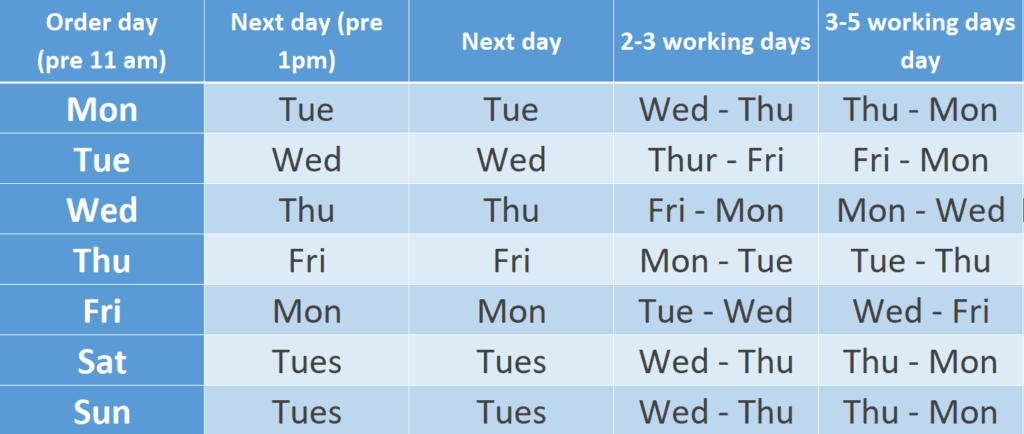How to soundproof a ceiling
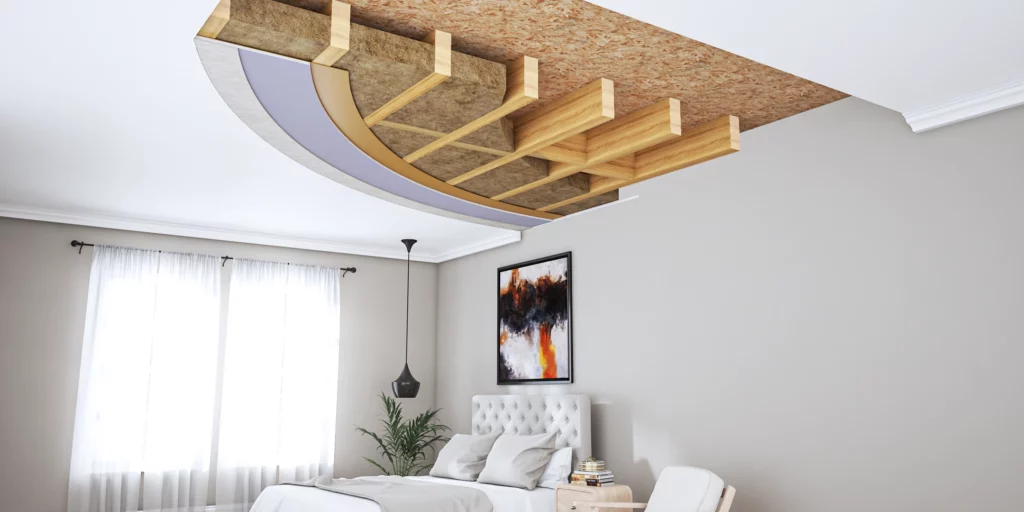
How to soundproof a ceiling (The basics)
In this guide, we will give you guidance on how to soundproof a ceiling. We want to make sure you feel comfortable with the terminology we use, the best course of action to take with intrusive noise issues which can be applicable to all sorts of building types and navigation around our website which will take you to further reading on particular areas regarding soundproofing – this is highly effective in giving you the knowledge to start your path into soundproofing.
A brief explanation of sound
Before we look at ceiling soundproofing lets learn a little about sound. Sound is made up of a broad spectrum of frequencies which are created by vibrations; when you tap your foot, when you close the door, when you hum a tune – all of these create vibrations that result in the sound you hear and process.
Depending on the frequency of sound the lower the sound is in pitch, the more energy it contains and the more likely it is to travel in all directions and through a range of materials (this could be brick or block work for example)
We have provided a more in-depth description of sound in our ‘A Guide to Sound‘
If we take a 3-way speaker box for example (3 speakers, one above another), we can relate this to how we listen to music. We will help to put it into context with everyday sounds and instruments we may find in these areas and how problematic they can be acoustically
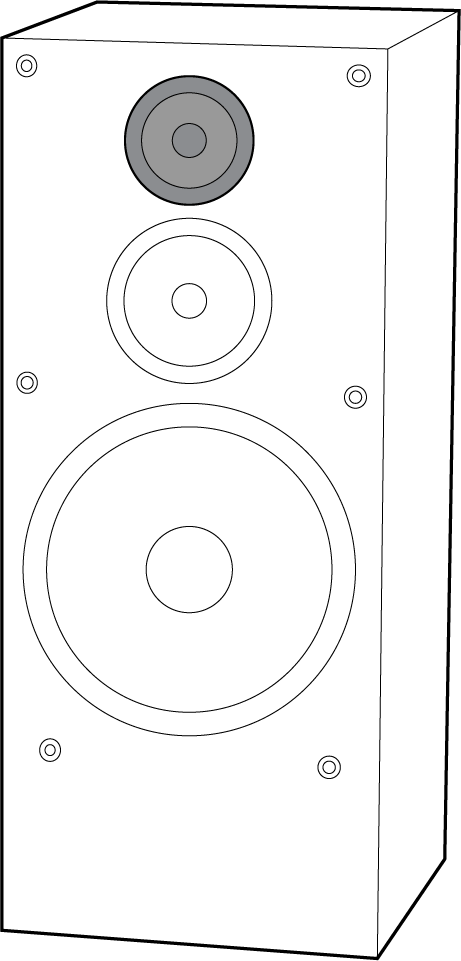
Tweeter (High Frequency)
This small domed speaker at the top reproduces high-frequency waves, high pitched in sound and is often at the top as most designers will aim to have it closer to head height. The reason for this is that the high-frequency noise is very directional (less likely to travel equally in all directions) because of the energy it contains, it doesn’t travel very far. If you put your speakers on and move into the next room, you will most likely hear that the higher-pitched noises are experienced far less than the lower frequencies.
This means that the energy we spoke about, will find it harder to move through dense materials, a brick wall or plasterboard for example.
- 4khz – 20khz (Kilohertz)
- Examples of high frequency;
- Voice (especially in sibilance which consists of the wooshing and hissing sounds of speech, say the line She Sells Sea Shells by the Sea Shore, lots of sibilance in this example)
- Drum cymbals, high end of guitar
- A micro-wave completion tone (the beeps once it has completed)
- Whistling
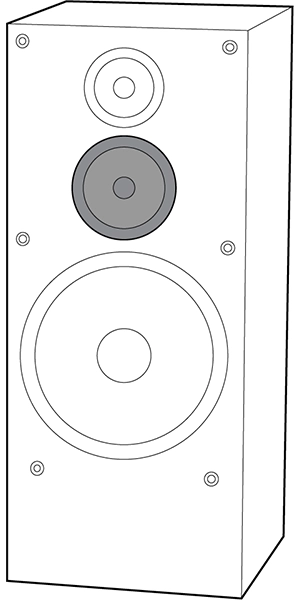
Mid-Range (Mid-range Frequency)
This middle-sized speaker, also in the middle of the speaker reproduces the broadest range of frequencies, therefore contains the body of most sounds we hear. The lower we come down in direction of Mid-range, the more omnidirectional (sound travelling in all directions) it becomes. It contains more energy than higher frequency noises and on the lower spectrum, can still be readily heard through a range of materials – with some being dimmed the higher we go.
- 250hz (Hertz) to 4khz (Kilohertz)
- Examples of middle frequency;
- Voice can start off at around 250hz
- Brass instruments
- Hand percussion
- Television
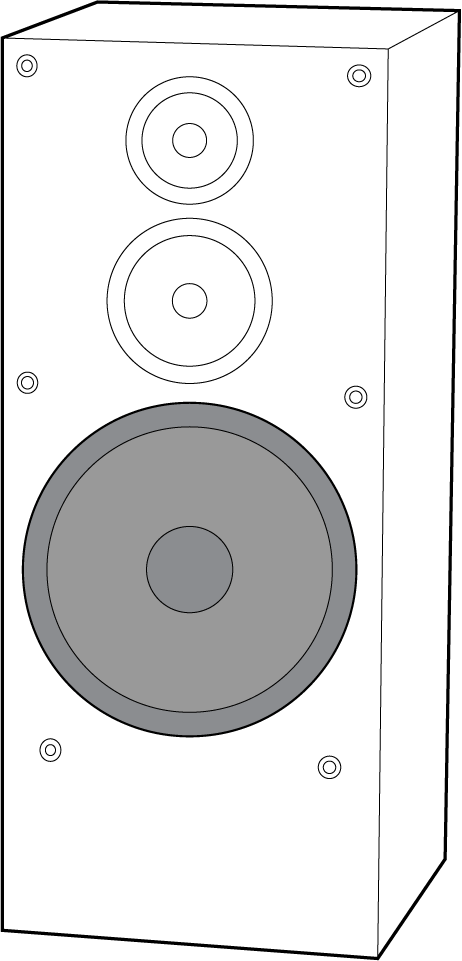
Bass (Low Frequency)
This speaker you will notice as larger of the three, this is because it needs to move an incredible amount of air, which produces large wave-forms, and this results in an increased amount of sound energy which is omnidirectional, meaning that this sound will travel through a vast array of surfaces and materials, it can sound like it is coming from everywhere, which in most cases – it is.
An example of this would be hearing a party happening in the distance, you will always hear the thudding of a kick drum or a bass line.
- 20hz -250hz (Hertz)
- Examples of Low Frequency
- Kick drum
- Voice (this can be both male and female) creating muffled experience through a wall
- Impact noise (footsteps, doors closing)
- Cooker or microwave humming
- Washing machine or other appliances in operation
You will want to look at the next section as a way of surveying the noise and the path to tackling certain noise issues
How ceiling soundproofing works
Ceiling soundproofing works through the physical properties of mass, spring/suspension and absorption, which means that the best acoustic system would have;
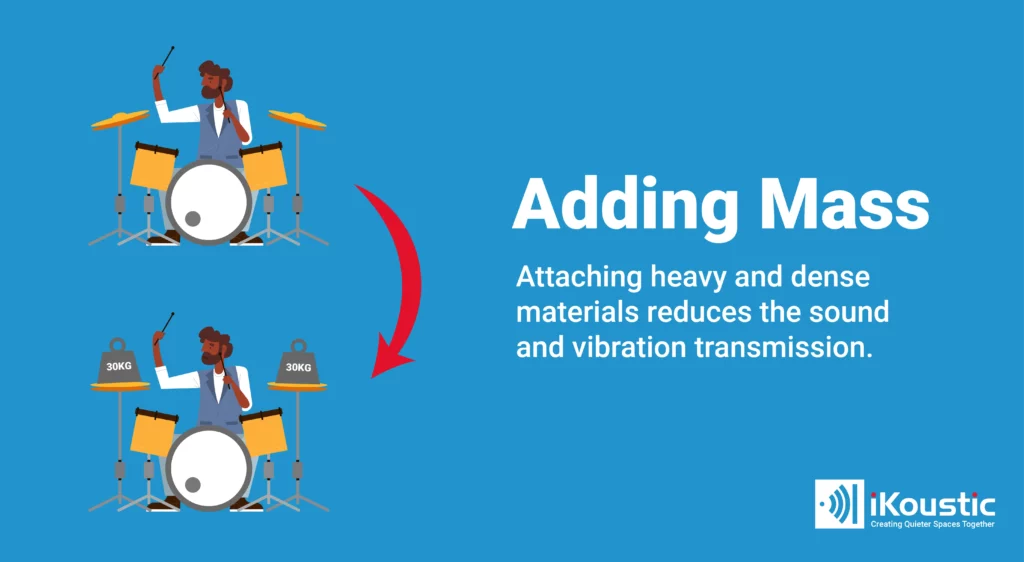
A heavyweight to reflect the sound (Mass)
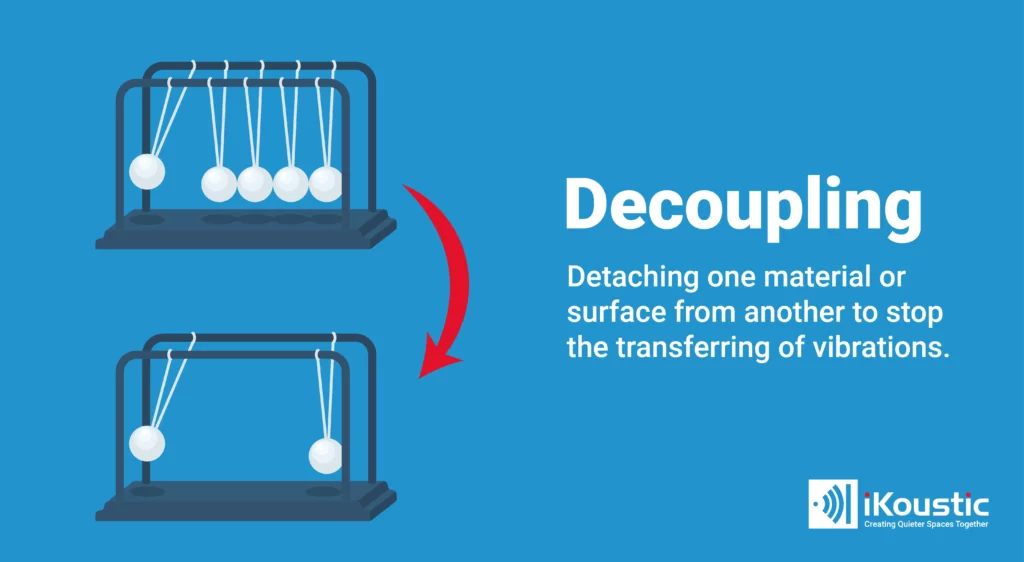
An element of elasticity, spring or (Separation)
Absorption quality in all adjacent cavities (Absorption)
When reviewing ceiling soundproofing, it is important to note that noise issues are never completely blocked, the best reduction is when the noise issues reach a background noise level, this is as sound travels in multiple directions and through different parts of your building (see flanking below). You can find a more in-depth discussion on our Science of Soundproofing page, there is also a very handy dB graph here of different noise levels.
When looking at your ceiling soundproofing options, you will often see acoustic results which should always be displayed with an acoustic system in place. An acoustic system would always include the partition, this being a chipboard flooring or other, concrete flooring and potentially acoustic flooring systems in place above and the ceiling soundproofing materials in place – you would not have testing results on an individual product.
One example we come across is direct board options in the region of 45-50dB, please note that this will include the partition – where a concrete floor for example may be 50-60dB of airborne reduction, and the board potentially 5-10dB airborne reduction. Impact noise may be reduced at floor level also, it is worth checking to see if these are in place. We display wherever possible our breakdown of partitions in our performance data.
Another important note is that ceiling soundproofing materials and systems are relative to the logarithmic scale, which means adding the same system twice, measuring 10dB – would not result in 20dB overall.
A noise checklist
We want to make sure you have everything you need to progress on to the next stage, whether this is deciding to go ahead with the project, to ask iKoustic for a quotation or to place an order – we will help each step of the way.
- Listen to what noises you hear, is it conversation, TV, doors slamming or footsteps for example, or a combination of noises?
- Are noise issues one of the options below?
- Inaudible or background level, so when you are in your room, typical noises mask this noise issue.
- Muffled, you can make out there is certainly a noise – but you wouldn’t be able to tell what it is, or what words they are saying.
- Clear, you can tell what the noise is and hear words for example, clearly.
- Are some noises more problematic than others?
- Is there any Flanking noise? (See next section for a brief description or click on the word Flanking noise)
- Feel the surfaces, can you feel any vibration coming through?
- Take notes from anything you notice above, it will help visualise the issue
As sound is subjective, what may affect you more than others could be perhaps the slamming of a door, or a washing machine that seems to shake the whole house – but a conversation may not bother you.
Flanking Transmission
Another term you will regularly come across is Flanking (Sound, Transmission, Path) and what this essentially means is that in a ceiling construction, there will usually be multiple paths that the sound may travel through, below are some examples that could be in your home or workplace.
You can view this under our ‘A Guide to Flanking Transmission’.
We would recommend carrying out a small home test using an open end of a glass to every surface in the room and the base pressed against your ear whilst a sound is being conducted.
Helping to budget for your project
By budget, we are weighing up three variables that all directly have an impact on the efficiency of the ceiling soundproofing;
The cost
The space lost
The performance
As these all go hand in hand, our best performing ceiling soundproofing system is our MuteMat® 3 Plus for timber constructions, and our MuteCradle™ systems for concrete constructions. You can click on either option for more advice on the range.
You may want to take some time to talk with us about your options, having a budget in mind helps us point you in the right direction with coming up with the most effective solution for your budget.
What options do I have available?
We supply a full range of ceiling soundproofing options to help tailor to most budgets, we will break our options down below and give you a brief description.
About our Performance, Cost and Thickness below, it is marked on a scale of 1-10, 1 being the lowest, 10 being the highest. You can play around with the different options to see what works for you, all details such as; estimated reduction (with the best used environments) acoustic test results and space lost.
Option 1: MuteBoard® 2 System
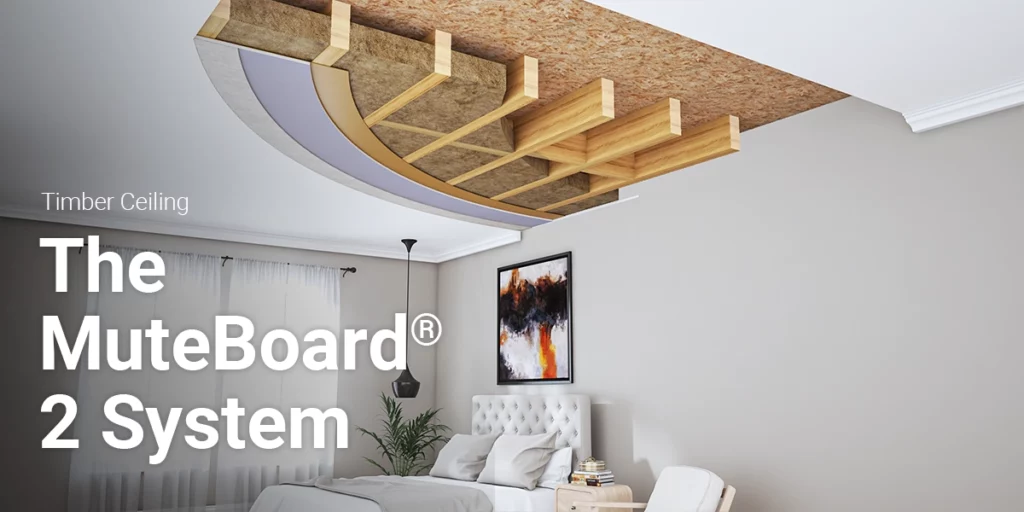
Performance Description
iKoustic’s MuteBoard® 2 system for ceilings is a brilliant option for those with a real premium for space. At only 19mm, this provides and upgrade to standard and acoustic plasterboard with an additional dampening layer added to the back with helps provide a little separation from the joists.
- Reducing background level of conversation
- Reducing background level of TV audio (this would exclude any soundbar or subwoofer due to the bass heavy sounds produced.)
Option 2: MuteClip® Timber Systems
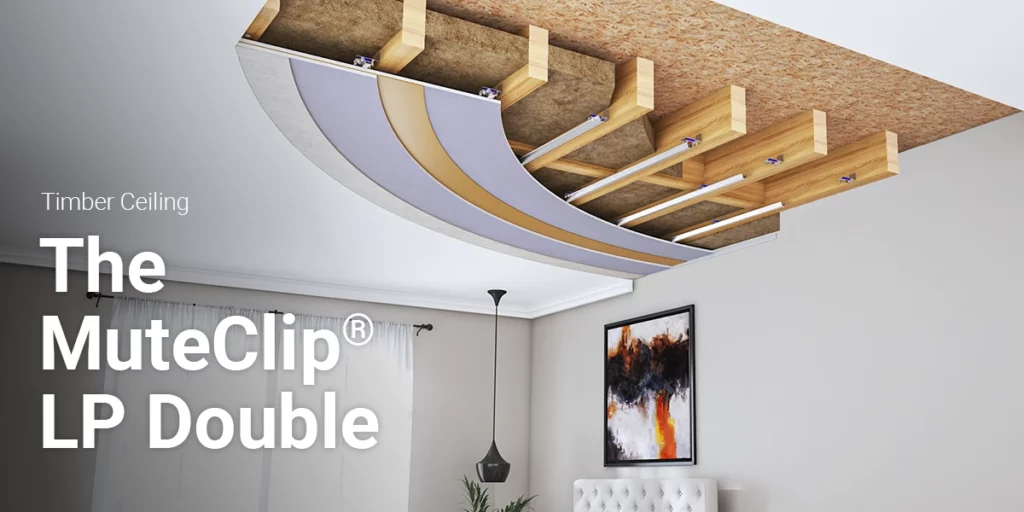
Performance Description
iKoustic’s MuteClip® System for timber constructions vary in all Performance, Cost and Thickness. For those looking for a slimmer ceiling height but the same highly effective performance, our MuteClip® LP can be used. For those with unlevel joists and want to reduce having to level these out, our MuteClip® XP can be used. For those without those requirements our Standard MuteClip® can be used.
- All single board systems are suitable for reducing lower levels of airborne noise and impact noise
- Reducing low levels of conversation
- Reducing low levels of TV and light music use (not including any soundbars or subwoofers)
- Reducing lower levels of impact noise such as footsteps
- All double board systems are more tailored towards the best reduction with those with the space to lose, suitable for reducing raised noise levels.
- Reducing raised conversation
- Reducing raised tv noise levels and music levels
- Reducing intrusive impact noise issues such as footsteps or moving furniture
Option 3: MuteClip® Concrete Systems
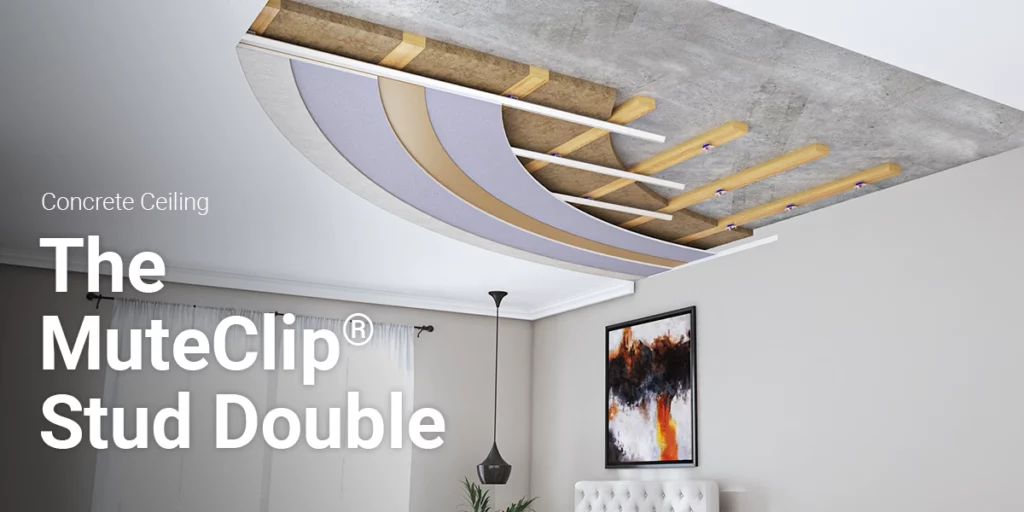
Performance Description
iKoustic’s MuteClip® System in a concrete construction is a highly effective way of reducing impact, airborne and vibration related noise issues. Improving the soundproofing properties of concrete is a little more difficult and usually requires a form of separation, so basically suspending mass away from the concrete slab, like using MuteClip® for example and a form of a stud frame, a stud frame especially if the noise issues are excessive.
- All single board systems are suitable for reducing lower levels of airborne noise and impact noise
- Reducing low levels of conversation
- Reducing low levels of TV and light music use (not including any soundbars or subwoofers)
- Reducing lower levels of impact noise such as footsteps
- All double board systems are more tailored towards the best reduction with those with the space to lose, suitable for reducing raised noise levels.
- Reducing raised conversation
- Reducing raised tv noise levels and music levels
- Reducing intrusive impact noise issues such as footsteps or moving furniture
What we do for you
Where to now?
You have made it this far, do get in contact with us we would love to hear from you and how we can help.
To help us, you will want to gather;
- Any plans you may have had of the build
- Dimensions of the ceiling
- We would need a perimeter reading of each room to calculate perimeter materials
- Any images, this can help us detect any more potential issues

